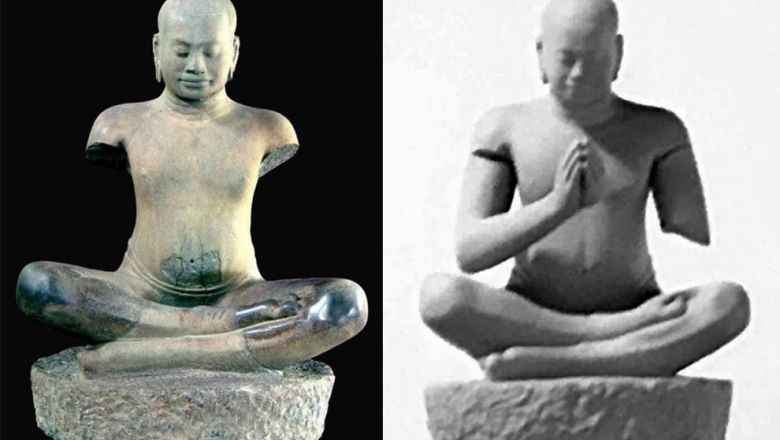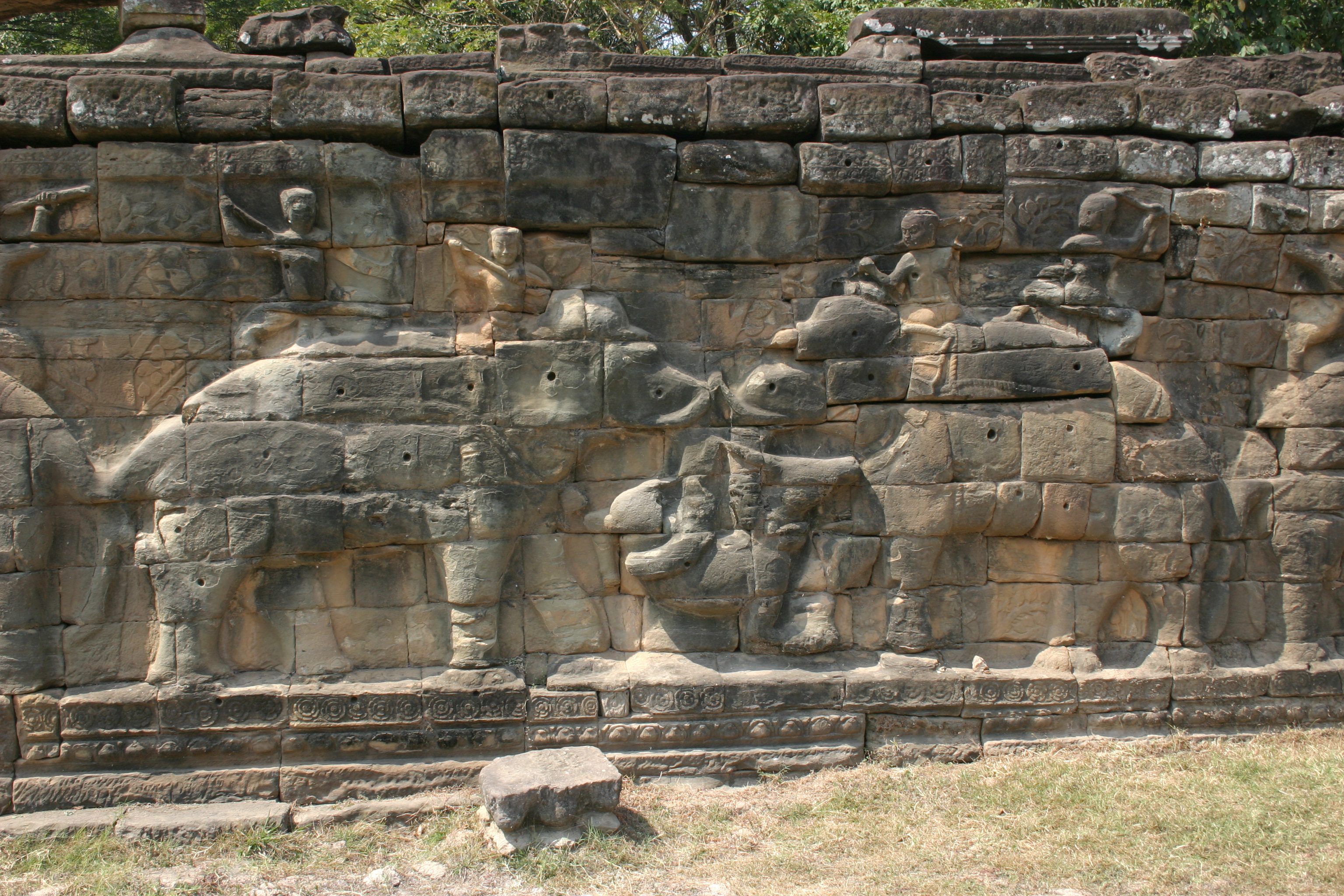|
Prasat Suor Prat
Prasat Suor Prat ( km, ប្រាសាទសួព្រ័ត) is a series of twelve towers spanning north to south lining the eastern side of a royal square in Angkor Thom, near the town of Siem Reap, Cambodia. The towers are made from rugged laterite and sandstone. They are right in front of Terrace of the Elephants and Terrace of the Leper King, flanking the start of the road leading east to the Victory Gate, on either side of which they are symmetrically arranged. Their function remains unknown. The current tower's name in Khmer means "The towers of the tightrope dancers," a romantic idea derived from the local belief that they were used to support a high wire stretched between them for acrobatics during royal festivals. This belief, however, is irrelevant. Zhou Daguan describes in his records that the towers are used to settle disputes among Angkorian people. The temple was possibly built during the reign of Indravarman II.Higham, C., 2001, The Civilization of Angkor, Lo ... [...More Info...] [...Related Items...] OR: [Wikipedia] [Google] [Baidu] |
Cambodia
Cambodia (; also Kampuchea ; km, កម្ពុជា, UNGEGN: ), officially the Kingdom of Cambodia, is a country located in the southern portion of the Indochinese Peninsula in Southeast Asia, spanning an area of , bordered by Thailand to the northwest, Laos to the north, Vietnam to the east, and the Gulf of Thailand to the southwest. The capital and largest city is Phnom Penh. The sovereign state of Cambodia has a population of over 17 million. Buddhism is enshrined in the constitution as the official state religion, and is practised by more than 97% of the population. Cambodia's minority groups include Vietnamese, Chinese, Chams and 30 hill tribes. Cambodia has a tropical monsoon climate of two seasons, and the country is made up of a central floodplain around the Tonlé Sap lake and Mekong Delta, surrounded by mountainous regions. The capital and largest city is Phnom Penh, the political, economic and cultural centre of Cambodia. The kingdom is an elective co ... [...More Info...] [...Related Items...] OR: [Wikipedia] [Google] [Baidu] |
Angkor
Angkor ( km, អង្គរ , 'Capital city'), also known as Yasodharapura ( km, យសោធរបុរៈ; sa, यशोधरपुर),Headly, Robert K.; Chhor, Kylin; Lim, Lam Kheng; Kheang, Lim Hak; Chun, Chen. 1977. ''Cambodian-English Dictionary''. Bureau of Special Research in Modern Languages. The Catholic University of America Press. Washington, D.C. Chuon Nath Khmer Dictionary (1966, Buddhist Institute, Phnom Penh). was the capital city of the Khmer Empire. The city and empire flourished from approximately the 9th to the 15th centuries. The city houses the Angkor Wat, one of Cambodia's most popular tourist attractions. The name ''Angkor'' is derived from ''nokor'' (), a Khmer word meaning "kingdom" which in turn derived from Sanskrit ''nagara'' (), meaning "city". The Angkorian period began in AD 802, when the Khmer Hindu monarch Jayavarman II declared himself a "universal monarch" and "god-king", and lasted until the late 14th century, first falling under ... [...More Info...] [...Related Items...] OR: [Wikipedia] [Google] [Baidu] |
Jayavarman VII
Jayavarman VII, posthumous name of Mahaparamasaugata ( km, ជ័យវរ្ម័នទី៧, c. 1122–1218), was king of the Khmer Empire. He was the son of King Dharanindravarman II (r. 1150–1160) and Queen Sri Jayarajacudamani. He was the first king devoted to Buddhism, as only one prior Khmer king was a Buddhist. He then built the Bayon as a monument to Buddhism. Jayavarman VII is generally considered the most powerful of the Khmer monarchs by historians. His government built many projects including hospitals, highways, rest houses and temples. With Buddhism as his motivation, King Jayavarman VII is credited with introducing a welfare state that served the physical and spiritual needs of the Khmer people. Defeat of the Cham and coronation In 1177 and again in 1178, the Cham invaded the Khmer Empire. In 1177, Champa King Jaya Indravarman IV launched a surprise attack on the Khmer capital by sailing a fleet up the Mekong River, across Lake Tonlé Sap, and then up ... [...More Info...] [...Related Items...] OR: [Wikipedia] [Google] [Baidu] |
Angkor Thom
Angkor Thom ( km, អង្គរធំ ; meaning "Great City"), alternatively Nokor Thom ( km, នគរធំ ) located in present-day Cambodia, was the last and most enduring capital city of the Khmer empire, Khmer Empire. It was established in the late twelfth century by King Jayavarman VII.Higham, C., 2014, Early Mainland Southeast Asia, Bangkok: River Books Co., Ltd., It covers an area of 9 km², within which are located several monuments from earlier eras as well as those established by Jayavarman and his successors. At the centre of the city is Jayavarman's state temple, the Bayon, with the other major sites clustered around the Victory Square immediately to the north. The site is one of the major tourist attractions of southeast Asia. Etymology Angkor Thom ( km, អង្គរធំ) is the transform name from another alternative name of Nokor Thom ( km, នគរធំ), which is believed to be the correct one, due to neglect of calling it in incorrect pronunciatio ... [...More Info...] [...Related Items...] OR: [Wikipedia] [Google] [Baidu] |
Siem Reap
Siem Reap ( km, សៀមរាប, ) is the second-largest city of Cambodia, as well as the capital and largest city of Siem Reap Province in northwestern Cambodia. Siem Reap has French colonial and Chinese-style architecture in the Old French Quarter and around the Old Market. In the city, there are museums, traditional Apsara dance performances, a Cambodian cultural village, souvenir and handicraft shops, silk farms, rice paddies in the countryside, fishing villages and a bird sanctuary near Tonlé Sap, and a cosmopolitan drinking and dining scene. Cambodia’s Siem Reap city, home to the famous Angkor Wat temples, was crowned the ASEAN City of Culture for the period 2021–2022 at the 9th Meeting of the ASEAN Ministers Responsible for Culture and Arts (AMCA) organised on Oct 22, 2020. Siem Reap today—being a popular tourist destination—has many hotels, resorts, and restaurants. This owes much to its proximity to the Angkor Wat temples, Cambodia's most popular touri ... [...More Info...] [...Related Items...] OR: [Wikipedia] [Google] [Baidu] |
Terrace Of The Elephants
The Terrace of the Elephants ( km, ព្រះលានជល់ដំរី) is part of the walled city of Angkor Thom, a ruined temple complex in Cambodia. The terrace was used by Angkor's king Jayavarman VII as a platform from which to view his victorious returning army. It was attached to the palace of Phimeanakas ( km, ប្រាសាទភិមានអាកាស), of which only a few ruins remain. Most of the original structure was made of organic material and has long since disappeared. Most of what remains are the foundation platforms of the complex. The terrace is named for the carvings of elephants on its eastern face. The 350m-long Terrace of Elephants was used as a giant reviewing stand for public ceremonies and served as a base for the king's grand audience hall. It has five outworks extending towards the Central Square-three in the centre and one at each end. The middle section of the retaining wall is decorated with life size garuda and lions; towards e ... [...More Info...] [...Related Items...] OR: [Wikipedia] [Google] [Baidu] |
Terrace Of The Leper King
The Terrace of the Leper King (or Leper King Terrace) (, ''Preah Lean Sdach Kumlung'') is located in the northwest corner of the Royal Square of Angkor Thom, Cambodia. It was built in the Bayon style under Jayavarman VII, though its modern name derives from a 15th-century sculpture discovered at the site. The statue depicts the Hindu god Yama, the god of death. The statue was called the "Leper King" because discolouration and moss growing on it was reminiscent of a person with leprosy, and also because it fit in with a Cambodian legend of an Angkorian king Yasovarman I who had leprosy. The name that the Cambodians know him by, however, is ''Dharmaraja'',''Dharmaraja'', 'King of Dharma' is a title of Yama. as this is what was etched at the bottom of the original statue. The U-shaped structure is thought by some to have been used as a royal cremation Cremation is a method of Disposal of human corpses, final disposition of a Cadaver, dead body through Combustion, burning. Cremat ... [...More Info...] [...Related Items...] OR: [Wikipedia] [Google] [Baidu] |
Khmer Language
Khmer (; , ) is an Austroasiatic languages, Austroasiatic language spoken by the Khmer people, and the Official language, official and national language of Cambodia. Khmer has been influenced considerably by Sanskrit and Pāli, Pali, especially in the royal and religious Register (sociolinguistics), registers, through Hinduism and Buddhism. It is also the earliest recorded and earliest written language of the Mon–Khmer family, predating Mon language, Mon and Vietnamese Language, Vietnamese, due to Old Khmer being the language of the historical empires of Chenla, Angkorian Empire, Angkor and, presumably, their earlier predecessor state, Funan. The vast majority of Khmer speakers speak Central Khmer, the dialect of the central plain where the Khmer are most heavily concentrated. Within Cambodia, regional accents exist in remote areas but these are regarded as varieties of Central Khmer. Two exceptions are the speech of the capital, Phnom Penh, and that of the Khmer Khe in Stung ... [...More Info...] [...Related Items...] OR: [Wikipedia] [Google] [Baidu] |
Zhou Daguan
Zhou Daguan (; French: Tcheou Ta-Kouan; c. 1270–?) was a Chinese diplomat of the Yuan dynasty of China, serving under Temür Khan (Emperor Chengzong of Yuan). He is most well known for his accounts of the customs of Cambodia and the Angkor temple complexes during his visit there. He arrived at Angkor in August 1296, and remained at the court of King Indravarman III until July 1297. He was neither the first nor the last Chinese representative to visit the Khmer Empire. However, his stay is notable because he later wrote a detailed report on life in Angkor, ''The Customs of Cambodia'' () . His portrayal is today one of the most important sources of understanding of historical Angkor and the Khmer Empire. Alongside descriptions of several great temples, such as the Bayon, the Baphuon, Angkor Wat, and others, the text also offers valuable information on the everyday life and the habits of the inhabitants of Angkor. Biography Zhou was a native of Yongjia, a name often used in Zh ... [...More Info...] [...Related Items...] OR: [Wikipedia] [Google] [Baidu] |


_(6918753837).jpg)


